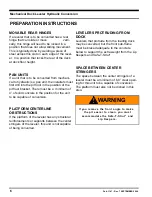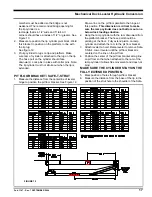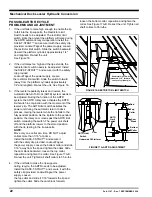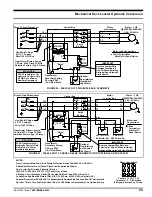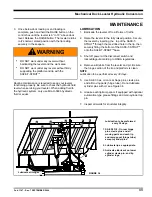
Pub. 1147 - Rev. 7 SEPTEMBER 2004
19
Mechanical Dock Leveler Hydraulic Conversion
ELECTRICAL WIRING
1. Connect electrical wiring per Figures 18-27
.
Be
sure to use the correct wiring diagram for the power
provided and the pump assembly ordered.
2. Install the operation switch per Figure 2.
LIP KEEPERS
1. Using the hoist, slowly lower the leveler platform.
While lowering, make sure the stringers of the
leveler do not impact the pump assembly and other
parts. Also check that the ramp cylinder does not
bottom out.
2. With the leveler flush with the pit wall, mark the
position of the lip keepers on the front of the frame.
Place strut under leveler.
3. Weld lip keepers in place. See Figure 14B for
recommended lip keeper support for levelers with
inadequate front
subframes.
UNIT TEST
1. With the unit fully lowered, activate the power switch
to partially raise the leveler platform. Allow the
leveler to return itself to the lip keepers. Do this
several times to purge the air from the system.
2. Raise the leveler to the full open position and check
for leaks. If leaks do occur, place the leveler on the
Safe-T-Strut and repair leaks.
3. IMPORTANT: With the strut in place (through the lip
hole and on the strut base) test that the leveler does
not lift above the strut top or interfere with the
leveler operation in any way. If the strut does not
remain captured by the lip or if the strut binds in the
lip: consult Rite Hite for the correct strut application.
4. Refill hydraulic fluid tank to indicated level.
BRACKET ADJUSTMENTS
1. Lower leveler to below dock end load position. If
ramp cylinder bottoms out, adjust pit floor bracket
toward front of pit one set of holes.
2. Raise leveler to highest position. Insure toe guards
do not come out of pit.
3. Weld the ramp platform bracket securely in place.
This includes welding this bracket to its base and
the stringers of the platform.
4. Weld the movable portion of the pit floor bracket to
its base. Leave bolts in place.
5. Paint all brackets and welds to control rust.
PUMP ADJUSTMENTS
1. Run leveler and adjust properly
a. Adjust shuttle valve so that leveler platform
lowers from top to bottom in 14-16 seconds.
-Adjust the shuttle valve in 1/8-1/4 turn at a time
to speed platform decent
-Adjust the shuttle valve out 1/8-1/4 turn at a
time to slow platform decent
2. Lip control adjustment
a. Adjust the sequence valve
IN
1/4 turn at a time
to slow lip kick at the top of the cycle and stop
lip kick at below dock start up.
b. Adjust the sequence valve
OUT
1/4 turn at a
time to speed lip kick at the top of the cycle. Be
careful not to create a lip kick situation at a
below dock start up.
AUTOMATIC RETURN TO DOCK
(ARTD)
GENERAL
The ARTD limit switch assembly automatically turns the
hydraulic power unit on and off to recycle the leveler
from below dock level to dock level, provided the lip has
been fully extended. A recycle actuator with a rotary
cam assembly moves forward and backward with the
extension and retraction of the lip cylinder. The cylinder
rod moves forward (out) to extend the lip, and backward
(in) to retract the lip.
See Figure 17.
ARTD OPERATION
When the RAISE button is pressed and the ramp
cylinder has fully extended, the lip cylinder rod extends.
The roller of the ARTD limit switch contacts the cam
block, causing the cam to rotate into its “Cylinder
Extend” position. After the cam block passes beyond the
end of the roller plunger limit switch, the cam returns to
its “Cylinder Retract” position. When the lip lowers
toward the pendant position, the lip cylinder retracts,
moving the cam assembly backward. The cam block
contacts the roller of the limit switch, closing the switch.
The power unit is activated, raising the leveler. As soon
as the lip has lowered to the fully pendant position, the
cam block moves past the roller of the limit switch,
which opens the switch and stops the hydraulic power
unit. The leveler returns to the stored position with the
pendant lip lowering into the lip supports. See Figure 17.
The restrictor limit switch prevents the leveler from
raising too high. See Figure 16.


